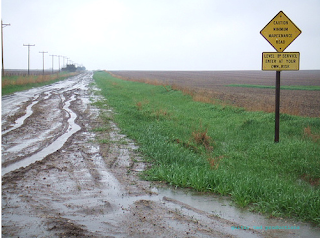 |
| One of the long standing iconic Trans Iowa images- T.I.v2 just North of Sutherland, IA |
You might scoff at that notion, but think about it more, and you will see why I felt that way, right up to the very end of Trans Iowa v14. It's like this, while you may not at first see the danger in putting on a Trans Iowa, it doesn't mean it isn't there. The very real possibility that someone could get seriously injured, or even die, was not a circumstance that was unlikely. Especially when you are dealing with a field of riders that is putting themselves into situations where decision making is sometimes compromised severely due to exhaustion or other physical and mental stress. And you realize that you have no control over those decisions.
Never mind the potential of offending land owners, pet owners, or ticking off the local volunteer fire department chief. (All of which happened during various Trans Iowas) Never mind the possibilities of people getting very lost, going way off course to quit and go back to the start, or wandering around off course severely dehydrated. (All of which happened at Trans Iowas) Yes, the very real chance of severe injury and death never happened, but it very well could have, and there were situations where I was very fortunate things went the way that they did.
Trans Iowa was dangerous, I knew that going in, so, why get involved at all?
That's a question I didn't have the answer for until very recently. In fact, at the onset of Trans Iowa, I was fairly cavalier about the possibilities for danger. I recall in messages back and forth with Mike Curiak, himself a promoter of ultra-endurance events at that time, and thinking along the lines of, "Well, maybe in Colorado, or Alaska you might have a rider die, but in Iowa? There is a farmer right down the road willing to help." And while that was true, and while we did see a lot of the goodness of people helping people, the danger factor was still there.
So, while I may have been oblivious, to a degree, to the potential dangers of Trans Iowa, I had no idea what other elements of "danger" were lurking in the unfolding of the event. Jeff, well, he was accustomed to the danger, in terms of the riding, and was willing to accept that as being part of a "good event's DNA". I mean, without the danger, what is there?
 |
| Joel Dyke (L), co-founder of Dirty Kanza, at T.I.v2 |
Jeff and I had hit upon a bit of something "dangerous" with Trans Iowa. Not just in a physical sense, but in the sense that it went against all the "rules" of racing bicycles. It was rebellious, it wasn't conforming, and Trans Iowa upset a lot of people out of the gates because of this. The "you can't do that" mentality was something that was definitely against us, and the element of what something like a Trans Iowa idea could do was dangerous to the status quo of the day in racing. It obviously was an event that was far too small to be, by itself, a revolution, but what it set off became that revolution. Only by looking back today can we see how dangerous it really all was.
Then again, Trans Iowa's irreverent take on racing was attractive to many. The new connections on the internet made networking with like-minded miscreants easy. A sort of punk rock ethos arose where people were inspired by what Jeff and I had created and it sprung up all across the nation in the form of gravel and back road based events put on by regular folks. Folks like Joel Dyke, who along with his partner, Jim Cummings got wind of this crazy Trans Iowa nonsense and figured they could do something like it in Kansas. Joel Dyke, who actually came and rode in the first two Trans Iowas, was very influenced by Trans Iowa and took a lot of what we were doing and brought it into their Dirty Kanza 200 event. Likewise, Jim Cummings has since ridden in several versions of Trans Iowa.
So, the subversive, "it isn't a race" style racing was taking root, and since then, has become so "dangerous" to the status quo that the bike industry, and even Pro road racers, finally just accepted it. Too many people were jumping ship and finding out what was going on "out there" on the gravel roads.
Now one might point here or there and, like Pete Thorn, say things are too "sanitized", too "nice". But I don't think the Rock & Roll is dead yet. But that's another story for another time.......
Next: I get back to the early days of Trans Iowa's story and how Mike Curiak helped formulate much of the framework of Trans Iowa going forward.

1 comment:
Down in the south heer whenever we first benn ridin dirt we called it clay roads ridin—love ya GT
Post a Comment